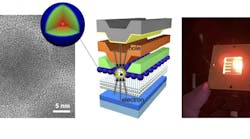Los Alamos scientists have shown they can amplify light using electrically excited films of quantum dots (i.e., chemically synthesized semiconductor nanocrystals). The films are put into devices much like the now-ubiquitous light-emitting diodes (LEDs), but, in this case, they are designed to sustain the high current densities required for achieving the optical-gain regime.
Laser diodes are common and can be found in laser pointers, barcode readers, and the like. A key element of such devices is an optical-gain medium, which amplifies incident light rather than absorbing it.
“We have been working to develop new lasing media, using chemically synthesized quantum dots, although it had been widely believed that quantum dot lasing with electrical stimulation is simply impossible,” says Victor Klimov, head of the quantum dot team at Los Alamos.
The success of the experiment demonstrates the feasibility of a new generation of highly flexible, electrically pumped lasers that can be used with or replace existing laser diodes fabricated using more complex and costly vacuum-based epitaxial techniques. These new devices could range from RGB laser modules for displays and projectors, to multi-wavelength micro-lasers for biological and chemical diagnostics.
These three images show a transmission electron microscopy image of the improved quantum dot and its representation (left), the schematic of the device that illustrates “current-focusing” idea (middle), and the device under operation (right).
The Los Alamos team used their “designer” quantum dots to amplify light in a nanocrystal solid with direct-current electrical pumping. The key property of the novel quantum dots is a carefully engineered particle interior in which the material’s composition continuously varies along a radial direction. This eliminates sharp steps in the atomic composition that would normally trigger Auger recombination. As a result, the quantum dots feature nearly complete suppression of the Auger effect’s heat loss, which allows for redirecting the energy released by the electrical current into the light-emission channel rather than into wasteful heat.
In these proof-of-principle experiments, quantum dots were stimulated with short (femtosecond) laser pulses used to outcompete optical gain decay caused by the Auger process. Short optical gain lifetimes create an especially serious problem in the case of electrical pumping, which is an inherently slow process as electrons and holes are injected into the quantum dot one-by-one.
Another important element of this work is a special “current-focusing” architecture that allows the high current densities necessary for optical gain. The method used by Los Alamos researchers was to taper one of the charge-injection electrodes, limiting the size of the current-conducting area to less than 100 microns. Employing this strategy, they produced current concentrations sufficient to reach the regime of light amplification without damaging either the dots or the injection layers.


